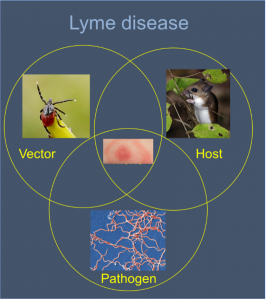 With an estimated rate of 300,000 cases per year, Lyme Borreliosis (LB) (also known as Lyme Disease [LD]) has become the primary vector-borne disease in the United and the fifth Nationally Notifiable disease. Lyme disease cases are concentrated in the Northeast and upper Midwest. However, during the last decade a clear southwesterly expansion of LB and its blacklegged tick vector (Ixodes scapularis) has been documented along Virginia’s eastern Appalachian foothills with current epidemic wave-front hovering just north of the North Carolina – Virginia border. Sporadic human cases have been described in north-western NC counties (Wake, Guilford, Haywood, Wilkes, Alleghany, and Buncombe). However, no information is available regarding the distribution and the abundance of the tick vector and rodent hosts and infection rates among them in these areas. During the last four years, we were funded by the North Carolina DHHS in order to conduct an active surveillance of the distribution of tick vector and the infection rates within their population. Using flagging, tick collection from hunted deer, and collection of ticks from small rodents, we detected a major cluster of tick and infection foci in the north western parts of NC and further work is being done in order to characterize the tick’s population structure, tick’s seasonal phenology and infection dynamics, and rodent host community structure and infection patterns.
With an estimated rate of 300,000 cases per year, Lyme Borreliosis (LB) (also known as Lyme Disease [LD]) has become the primary vector-borne disease in the United and the fifth Nationally Notifiable disease. Lyme disease cases are concentrated in the Northeast and upper Midwest. However, during the last decade a clear southwesterly expansion of LB and its blacklegged tick vector (Ixodes scapularis) has been documented along Virginia’s eastern Appalachian foothills with current epidemic wave-front hovering just north of the North Carolina – Virginia border. Sporadic human cases have been described in north-western NC counties (Wake, Guilford, Haywood, Wilkes, Alleghany, and Buncombe). However, no information is available regarding the distribution and the abundance of the tick vector and rodent hosts and infection rates among them in these areas. During the last four years, we were funded by the North Carolina DHHS in order to conduct an active surveillance of the distribution of tick vector and the infection rates within their population. Using flagging, tick collection from hunted deer, and collection of ticks from small rodents, we detected a major cluster of tick and infection foci in the north western parts of NC and further work is being done in order to characterize the tick’s population structure, tick’s seasonal phenology and infection dynamics, and rodent host community structure and infection patterns.